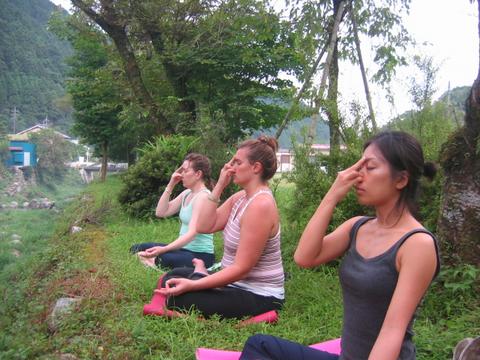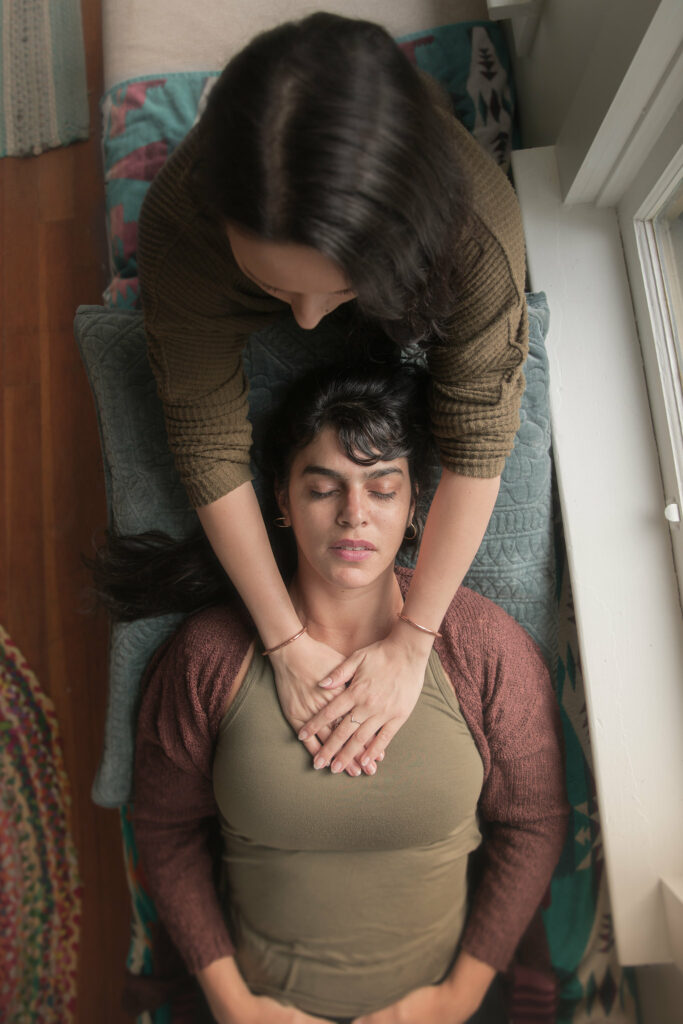Prana (your breath) and your mind are intricately linked. If you control your prana you will control your mind and you can handle everything.
The only condition, and this is true for everything in order to get results, is your involvement in the practice.
The more you listen to your ego, the less impact it will have on your mental and physical health.
And the more you know your ego, the more you can act on it to manifest the benefits of these practices on your body and mind. And only then will the transformation take place.


When prana (breath) moves, chitta (the mental force) moves.
When prana is without movement, chitta is without movement.
By this (regularity of prana), the practitioner achieves stability through the exercises mainly by the retention of the breath.
Prana and mind: the keys to work


Fluctuation of one, prana or mind, means fluctuation of the other. When either the mind or prana becomes balanced the other is steadied.
Hatha yoga says: control the prana and the mind is automatically controlled. While Raja yoga, which helps to achieve inner peace, meditation or dhyan, and stress relief, says: control the mind and the prana becomes controlled. These are two different paths of yoga but both are equally effective.
The mind is equated with a wild monkey, jumping here and there. Because of this inborn tendency it is very difficult to hold it still. Without consciousness of it and methods to relief these often erratic waves.
Mind control with the yoga path


Hatha yoga focuses on the well-being of the physical body and includes all the asanas. Asanas improve flexibility and posture, immunity, improves physical strength and body -mind counsciousness.
Hatha says let the mind be, concentrate on the autonomic body functions and vital energy, and the mind will become quiet by itself. When the nervous impulses are steady and rhythmic, the brain functions are regulated and the brain waves become rhythmic.
Without discipline and self involvment you can’t have any grip on it.
Disturbed Breath lead to internal disfunctions
The breathing process is directly connected to the brain and central nervous system. It is one of the most vital processes in the body system.
Breathing is not only an autonomic functional system, it is the only function of the autonomic nervous system over which we have control. It is also the only doorway to access to our patterns and traumas to modify and heal them. An incredible tool to IMMEDIATELY deactivate the monkey mind and access the emotions that fuel mental chatter, limiting beliefs and self-sabotage.
So now you undertsand why breathing properly is important to fight and heal from stress, anxiety and traumas.
How is it possible not to pay attention to our breathing? It is simple because breathing is automatic.
Breathing process also has some connection with the hypothalamus. It works directly on your autonomic system to seamlessly manage such functions as your heart rate, blood pressure and body temperature. It also works by releasing hormones that direct other hormones or other glands to manage other bodily functions like sleep, mood, emotional responses, muscle and bone growth and sexual drive.
The hypothalamus is responsible for transforming perception into cognitive experience. Erratic breathing sends erratic impulses to this center and thus creates disturbed responses.
There are also certain areas of the nasal mucous membrane which are connected to the visceral organs. When impulses coming from the nose are arrhythmic, the visceral organs, particularly those connected to the coccygeal plexus, respond in the same manner, arrhythmically. The coccygeal plexus is a nerve plexus near the coccyx bone.
So you understand that by being disturbed, these organs again send irregular impulses to the brain and cause more disharmony and imbalance. This cycle is continuous.
Awareness: the first step to change your mind
By becoming aware of the nature of the breath and by restraining it, the whole system becomes controlled.
When you retain the breath you are stopping nervous impulses in different parts of the body and harmonizing the brain wave patterns. In pranayama, it is the duration of breath retention which has to be increased. The longer the breath is held, the greater the gap between nervous impulses and their responses in the brain. When retention is held for a prolonged period, mental agitation is curtailed.
it exists more than 200 Pranayama to heal or regulate specific conditions. It is usually considered to be the practice of controlled inhalation and exhalation combined with retention.
However, technically speaking, it is only retention and inhalation/exhalation are methods of inducing retention.
Retention is most important because it is a longer period prana’s assimilation, and allows more time for the exchange of gases in the cells i.e. oxygen and carbon dioxide.
Patanjali (author of two great Hindu classics: the first, the Yoga-sutras, a categorization of yogic thought organized in four volumes with the titles “Psychic Power”, “Yoga Practice”, “Samadhi” (state of deep contemplation of the Absolute) and “Kaivalya” (separation); and the second, the Mahabhashya (“Great Commentary”) further says that retention of breath after expiration removes the obstacles to yoga.
Yoga is the union of the two poles of energy within us and during retention the poles come closest together. Breath retention must be developed in order to stop the fluctuations of the brain and mind so that a more expansive type of experience can develop.
Yoga is transformative
When you go further into yoga, there comes a time when you have some control of the mind so you can dive deeper within yourself.
When you practice mantra or meditation, the fluctuating mental waves create a barrier between you and the object you are trying to focus your awareness on.
So how to control the mind?


For many, many centuries, people have known that through pranic restraint you can control the influxes of the mind and through mental restraint you can control the influxes of prana, but various spiritual systems have been debating which is the best method to harness the two energies and induce unity.
Christ and Buddha said the same thing : “Lead a good life and your mind will be controlled.” Of course what they said is true, but people today are exposed to so many disturbing external factors that this approach does not work.
There are many good, charitable, pure-minded and compassionate people, but if you ask them to sit quietly, still the mind and meditate, they can’t do it.
Yama and niyama can help but difficult for modern day and support man. These disciplines has to be integrate in addition but not enough to be a very powerful method for developing mind control.
The body is designed for physiological healing
However, sciences and researches have demonstrated (see studies below) that through pranayama, mudras, bandhas and postures regulate the prana and the mind can be brought under control.
Many spiritual traditions, including Sufism, Buddhism and Hinduism, has already, long time ago, discovered that by focusing on the breath, you still the mind, develop one-pointedness and gain entry into the deeper realms of the mind and consciousness.
It exists a large pranayama’s and yogic practices to heal different pathologies or to follow a spiritual path to open skills.
Breathing gives us the ability to control our mental emotional state, it is a door to the subconscious mind to modify and heal patterns.
Aware of your conditions now?
And conscious that your health is your priority?
Without it you are mentally, psychologically and professionally reduced.
Do you want to learn? Get a free call with me to grow? Click here
References
Exploring the Therapeutic Benefits of Pranayama (Yogic Breathing): A Systematic Review
Exploring the therapeutic effects of yoga and its ability to increase quality of life
Effects of various Praṇayama on cardiovascular and autonomic variables.
